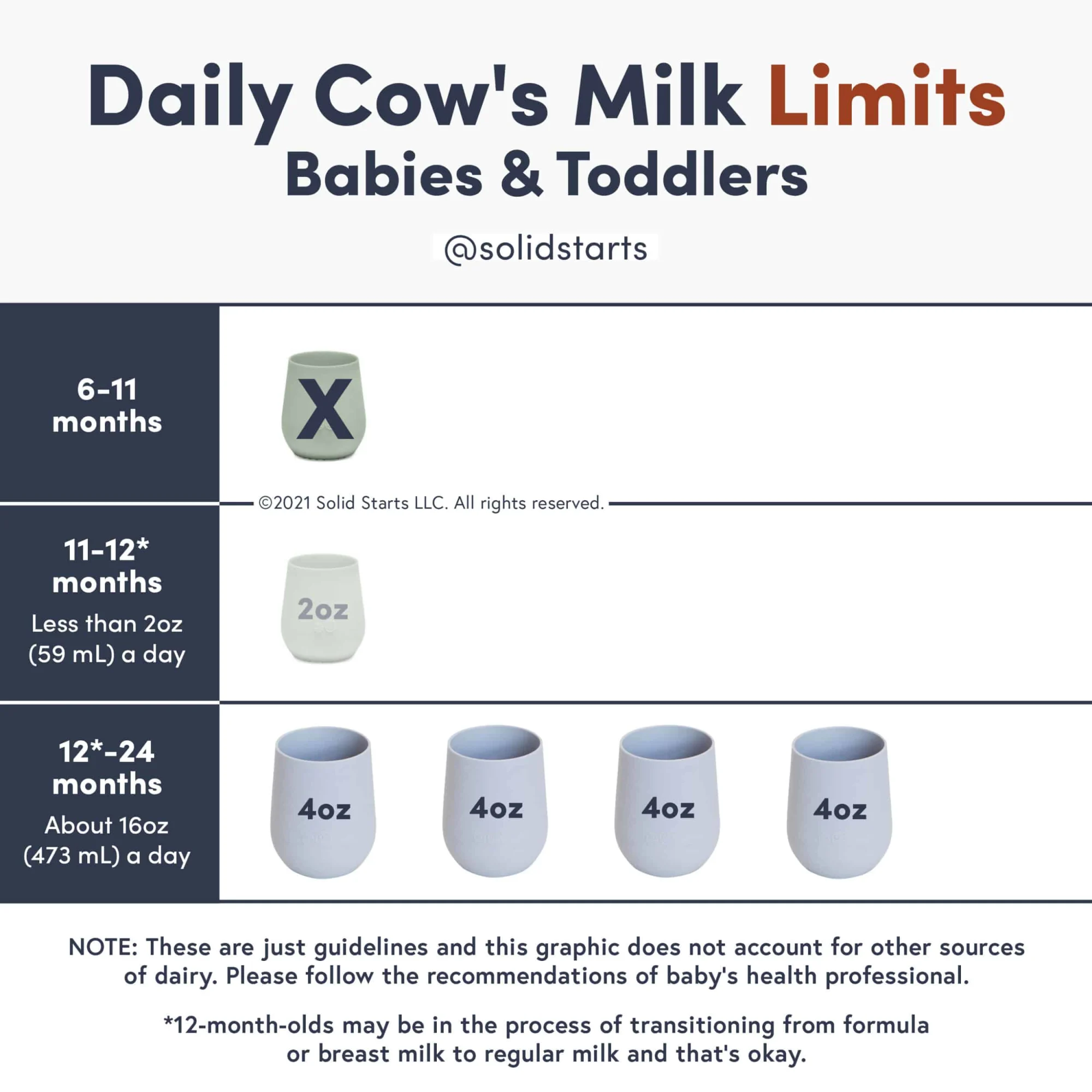Access our First Foods® Database in the Solid Starts App.
Learn moreMilk (Cow)
Dairy
Age Suggestion
12 months
Iron-Rich
No
Common Allergen
Yes

Warning
There is currently a recall on certain cow’s milk sold in the United States due to possible contamination with cleaning chemicals. Milk impacted by the recall is labeled as Prairie Farms Gallon FAT FREE Milk. Refer to the CDC for more details.
Compared to breast milk or formula, cow’s milk is nutritionally incomplete, which means that it does not provide all the nutrients babies need to thrive, and the digestive systems of babies may not well tolerate cow milk protein in large quantities. For these reasons, refrain from serving cow’s milk as a beverage until after a baby’s first birthday. Incorporating small amounts of cow milk as an ingredient in solid food (such as in oatmeal) however is fine.
When can babies have cow's milk?
Cow’s milk (or other milks from certain other hooved animals called ruminants) may be introduced in small amounts in food (such as warm cereal cooked with milk) as early as 6 months of age, but it is best to wait until 12 months of age to offer milk as a drink. For detailed information on milk alternatives, see our Milk FAQs.
There are thousands of mammal species on our planet, all of which produce milk to feed their young. Only a handful of these species have been domesticated and their milk used as a regular part of the human diet, the most common of which is the cow. Human consumption of cow milk is an ancient practice, but more recently, industrialization has affected the dairy industry both positively—making milk more widely and cheaply available—and negatively in the diversity and lifestyle of dairy cattle, which are commonly kept more confined than their ancestors were.
How do you serve milk to babies?
Every baby develops on their own timeline, and the suggestions on how to cut or prepare particular foods are generalizations for a broad audience.
6 to 11 months old:
Stick to breast milk or formula as baby’s main source of fluids, as the introduction of cow’s milk as a drink is discouraged at this age. A little bit of cow’s milk mixed into foods is fine as long as it doesn’t replace breast milk or formula.
11 to 12 months old:
At this age it is okay to offer small sips of whole cow’s milk (no more than 1-2 ounces) in an open cup to practice feeding skills and accustom baby’s palate to the new taste of cow’s milk. That said, it is also completely fine to not introduce cow’s milk at this age and continue breast milk or formula.
12 months old +:
Limit milk to no more than 16 ounces total per day or 2 servings total of dairy products daily so that milk doesn’t displace valuable nutrients such as iron from solids. Opt for whole cow’s milk and whole milk dairy products to provide enough fats and calories for healthy growth and development. If still consuming breast milk, children may not need as many servings of dairy since breast milk is also a good source of calcium in the diet.
24 months old +:
Toddlers can have up to 2-2.5 servings of dairy per day. You may hear recommendations to switch to a lower fat milk, but not all kids need low-fat milk, so be sure to speak with your pediatric health professional for more guidance.
Videos
Is milk a choking hazard for babies?
No. Milk presents a low risk when safely prepared for a child’s age and developmental ability, though, in theory, an individual could choke on any food. To reduce the risk, prepare and serve milk in an age-appropriate way as described in the How to Serve section. As always, make sure you create a safe eating environment and stay within an arm’s reach of baby during meals.
Learn the signs of choking and gagging and more about choking first aid in our free guides, Infant Rescue and Toddler Rescue.
Is milk a common allergen?
Yes, cow’s milk is classified as a common allergen by the World Health Organization. Cow’s milk is a common food allergen in young children, accounting for about one-fifth of all childhood food allergies. Keep in mind that dairy products from other ruminants such as sheep, goat, and buffalo may provoke similar allergic reactions to cow’s milk dairy products. That said, there’s good news: milk allergy often disappears with time. Research shows that the majority of children with cow's milk allergy will outgrow it by age 6 and many babies with milder symptoms of milk protein allergy (which can show up as painless blood in stool) are able to successfully reintroduce cow's milk as early as their first birthday, with the guidance of their appropriate pediatric health professionals. Even among those children who are not yet able to drink cow’s milk, many are able to tolerate milk that has been fully baked into a cake or muffin.
Milk is a common cause of food protein-induced enterocolitis syndrome, also known as FPIES. FPIES is a delayed allergy to food protein which causes the sudden onset of repetitive vomiting and diarrhea to begin a few hours after ingestion. This is termed acute FPIES. Left untreated, the reaction can result in significant dehydration. When milk is in the diet regularly, FPIES can present as reflux, weight loss, and failure to thrive - this is termed chronic FPIES. Symptoms generally improve with elimination of milk from the baby’s diet. Thankfully, like other forms of milk allergy, FPIES which presents early in life is generally outgrown by the time the child has reached 3-5 years of age.
Lactose intolerance, which is when the body has a hard time processing lactose, the sugar that is naturally present in milk, can sometimes be mistaken for an allergy as it can result in bloating, gas, diarrhea, nausea, and other discomfort. The good news is that lactose intolerance is uncommon in babies, toddlers, and younger children overall; however, intolerance tends to become more prevalent as babies grow older and may affect up to 70% of the world’s population. Be sure to connect with an appropriate pediatric health care professional for any questions about lactose intolerance and know there are many lactose-free dairy foods available.
If you suspect your baby may be allergic to dairy products, consult an allergist before introducing milk. Based on your baby’s risk factors and history, your allergist may recommend allergy testing, or may instead advise milk introduction under medical supervision in the office. If the risk is low, you may be advised to go ahead and introduce milk in the home setting. As with all common allergens, start by serving a small quantity on its own for the first few servings, and if there is no adverse reaction, gradually increase the quantity over future meals. Once common food allergens are successfully introduced, it is recommended to keep them in the diet regularly (twice weekly, if possible).
Is milk healthy for babies?
Yes, when served in food. Never serve cow’s milk as a drink to babies younger than 11 or 12 months of age, as it could displace the necessary nutrition from breast milk or formula, put baby at an increased risk of iron deficiency anemia, and tax baby’s digestive system, which may also contribute to anemia.
In addition to being an excellent source of protein to support growth and muscles and fat to fuel the brain, milk provides a plethora of vitamins and minerals. It offers plenty of vitamin D (when fortified) and calcium for strong bones, choline to bolster brain health, and vitamin A to nourish vision and the immune system. It contains most B vitamins, particularly significant amounts of vitamins B6 and B12, which help support the nervous system and a healthy metabolism. Milk also has significant amounts of zinc, in addition to selenium, phosphorous, and potassium and, in some cases, iodine.
This entry focuses on milk from cows, but goats, sheep, buffalo, yaks, and camels also produce milk that is commonly consumed by humans. Like cow’s milk, the nutritional content and quality of milk from these animals can vary with their diet and upbringing. In general, milk from these animals is nutritionally dense with similarities to cow’s milk, and some differences, of course. For example, goat, sheep, and buffalo milks are higher in calories, fat, protein, and calcium than cow’s milk. Camel milk is slightly lower in calories, but similar to cow’s milk in fat, protein, and calcium content. Interestingly, camel milk is unique as it contains a higher proportion of monounsaturated fats (a type of heart-healthy fat) and less saturated fat than that of cows. As with cow’s milk, these milks should not be introduced until after baby’s first birthday. To compare the nutritional content of various animal and plant-based milks, see our Milk FAQs.
★Tip: Cow’s milk purchased from a grocery store is often fortified with vitamin D as, on its own, milk may provide some vitamin D, but not a significant amount. When shopping for cow’s milk, opt for a vitamin-D fortified version to ensure you are providing enough of this important nutrient that is available in only a few foods.

When can babies drink raw milk?
There is no age at which consuming raw milk is without risk, so whether or when to serve it is a personal decision for which you must make an informed decision in the context of your child. Raw milk can harbor pathogenic bacteria and other potential contaminants that can increase the risk of foodborne illnesses, with more risk of severe symptoms in babies. Pasteurization—the process of heating a food to a certain temperature to kill bacteria—reduces the risk of foodborne illness and thus makes food safer to eat. For these reasons and more, many medical organizations recommend pasteurized milk for human consumption.
Our Team
Written by
Expert Tips Delivered to Your Inbox
Sign up for weekly tips, recipes and more!
Copyright © 2025 • Solid Starts Inc







